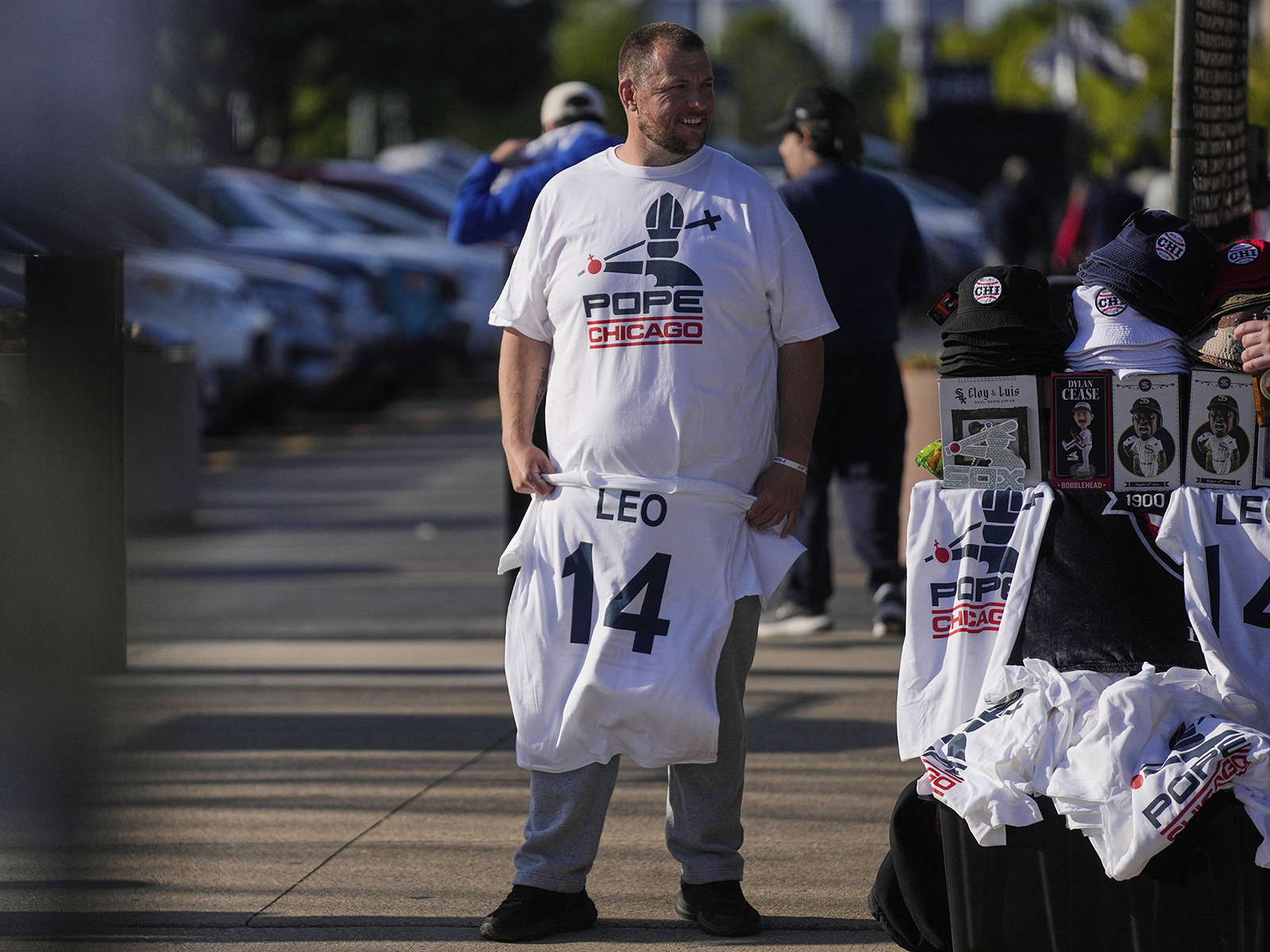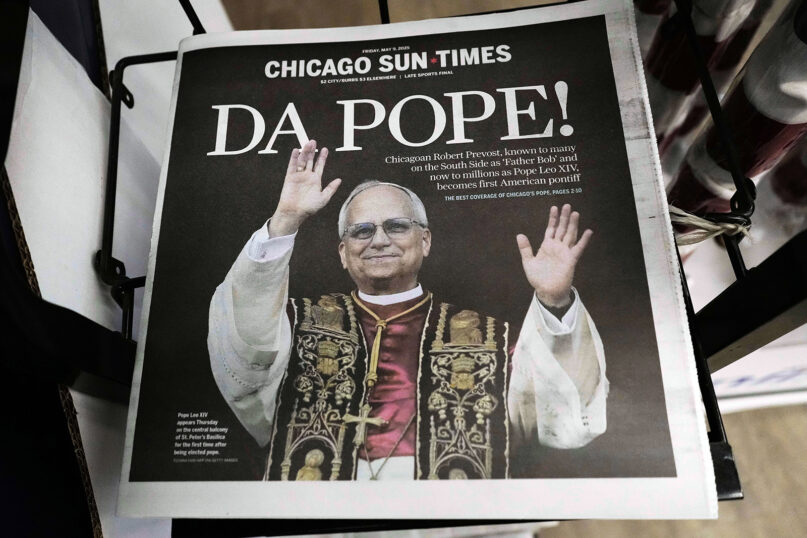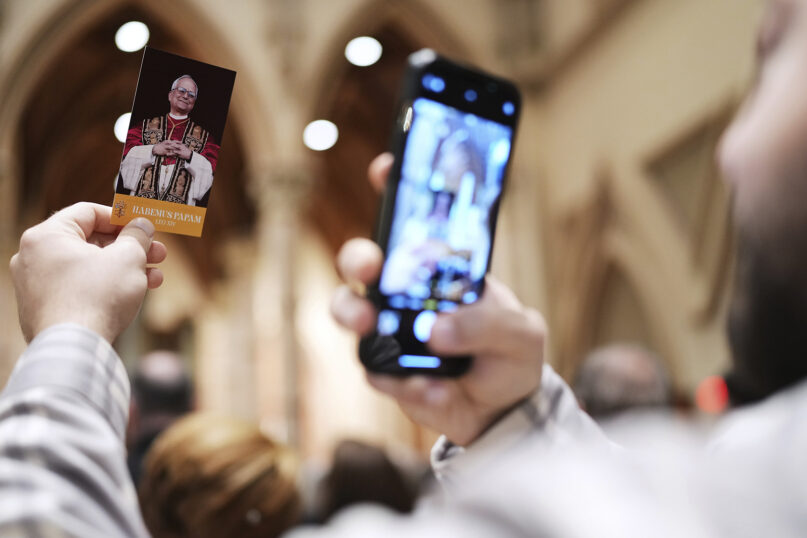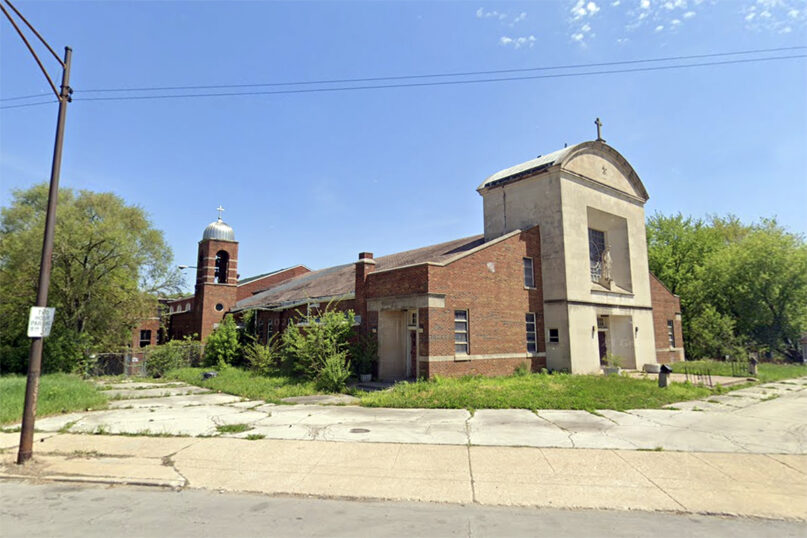
CHICAGO (RNS) — Bennison’s Bakery, a shop in Evanston, Illinois, just north of Chicago, is having great success with a recent addition to its selection: cookies plastered with an edible picture of Pope Leo XIV, waving to the crowd after his election.
As soon as news came that Leo — who grew up as Robert Prevost on East 141st Place in the Chicago suburb of Dolton — had been elected pope, Bennison’s owner, Jory Downer, called the shop and said, “No one can leave,” according to Jennifer Fournier, the bakery’s supervisor.
The Bennison team raced to find the photo of Leo and gave it to the store’s image cookie specialist, who designed a cookie bordered with sprinkles in Vatican red, white and yellow. The first day, the bakery sold 60 papal cookies, and it has now moved more than 2,000, including those they’ve shipped out of town in boxes.
“I kind of thought it would have died out by now, but nope,” Fournier said.
Church leaders in the Archdiocese of Chicago are hoping the same excitement that’s driving demand for Leo-based baked goods will translate into a renewal of the city’s famously deeply lived Catholic faith. For years, the archdiocese has been suffering a decline in attendance, mirroring a demographic shift across the country.
Recently, the archdiocese launched Renew My Church, an effort that has closed some parishes, including the Prevost family’s St. Mary of the Assumption in Dolton, and merged others, focusing resources on those with the most potential for growth.

Roman Catholic Cardinal Blase Cupich speaks at St. Nicholas Ukrainian Catholic Cathedral, Feb. 27, 2021, in Chicago. (RNS photo/Emily McFarlan Miller)
“Seventy percent of (the parishes) did not have the means to support themselves,” said Cardinal Blase Cupich, the archbishop of Chicago. “We had about $100 million of deferred maintenance. We also saw that we had shrinking numbers of pastors who could take care of that number of parishes, so we knew we had to do something.”
Over a six-year-long discernment process, Cupich said, the archdiocese identified ways to remove economic burdens to allow it to focus on spiritual renewal. By 2022, the number of parishes decreased from 350 to 247.
Now, Cupich said, he holds out hope that Leo’s witness can help turn around the shortage of priests.
“The man is genuinely authentic. He’s going to be able to speak to Americans in a language they understand, as an American speaking,” Cupich said. “So I think that he is going to help people to take a second look at the church.”
Chicago has a deep history with Catholicism. Among the first Europeans to set foot on the marshy banks of the Chicago River was a Jesuit missionary, the Rev. Jacques Marquette, in 1673, and its first Catholic parish was founded in 1833, the same year as the city was incorporated. As immigrants from Ireland, Poland and Germany poured into Chicago in the 19th century, its Catholic churches were the anchors of city life, and since 1924 it has been one of a handful of U.S. cities whose archbishop is customarily a cardinal.

A person dressed as a pope holds a cup and a hot dog during the sixth inning of a baseball game between the Miami Marlins and the Chicago White Sox, May 10, 2025, in Chicago. (AP Photo/Erin Hooley)
But greater Chicago’s Catholic population reached its peak at close to 2.5 million in 1970 and has since dropped to 1.9 million, while the number of diocesan priests has gone from 1,261 in 1975 to 670 in 2024. This year, only two diocesan priests were ordained in the Archdiocese of Chicago — down from four ordinations in 2024 and five in 2023.
The Archdiocese of Chicago will host a Mass June 14 at Rate Field, home of the White Sox, Leo’s favorite baseball team, building on the area’s excitement for his election.
“I think that (Leo), as a South Sider growing up in Chicago, is going to be able to offer a message to young people today about the importance of thinking about serving in a lifelong commitment of the church,” Cupich said. “That’s for religious men and women as well as priests.”
Even as a cardinal, the then Robert Prevost was little known among American Catholics, in part because he spent much of his career in Peru. But since his election, Chicagoans are exploring his connections to the city and its environs.
At DePaul University, the Catholic school in downtown Chicago where the pope’s parents attended, students describe a feeling of increased energy at the Catholic center on campus. “There’s been a buzz to it because it’s an American pope, and we’re in Chicago, where he’s from,” said DePaul University junior Liam Grimes, who grew up Catholic in northwest Indiana. “I was just taken aback. I was like, ‘Wow. I didn’t think it would have been an American pope.”

A Chicago Sun-Times newspaper front page shows “DA POPE!” at a grocery store in Mount Prospect, Ill., May 9, 2025. (AP Photo/Nam Y. Huh)
College has been a critical time for Grimes’ faith, he said, where studying Scripture and reading the early church fathers has led him to own his inherited religion, and commit to a daily prayer life.
“I pray, and we should all pray, that Pope Leo is a holy man and is faithful and does what he believes that God wants him to do as the leader of the Catholic Church,” Grimes said.
Michael Budde, a professor of Catholic studies at DePaul, said Leo is being welcomed with open arms right now, not only in Chicago but around the world.
“I think every pope, once new, has something of a honeymoon phase,” Budde said. “The world is starting to get to know what this person cares about, what their convictions are, what they’ve been willing to sort of take chances on to advance the deeper and the more substantive aspects of what it might mean to be a Christian in contemporary times.”
Budde agreed that Leo may cause Catholics and non-Catholics alike to see the church through new eyes and be willing to explore the faith more deeply. He cautioned, however, that the honeymoon phase will eventually end once Leo inevitably begins making controversial decisions.

A man takes a picture of a brochure that reads “A prayer of thankfulness for the election of Pope Leo XIV” during a Mass at Holy Name Cathedral in Chicago, May 11, 2025. (AP Photo/Nam Y. Huh)
“That might be quickly, that might be six months from now, but it’s not the sort of thing that goes on forever, because the nature of the responsibility is that, at least in part, being the leader of the church means that you respond to the agenda of the world.”
Nor is Leo likely to dramatically reverse the closures of churches due to financial pressures, in Chicago or elsewhere. “It’s been painful in Chicago. It’s been painful in Cleveland. It’s been painful in Washington, D.C.,” said Budde. “No place has found that to be a pleasant experience.”
Amid the celebrations of Chicago’s pope, the discovery of the pope’s childhood parish, St. Mary of the Assumption in the modest Riverdale neighborhood, serves as a symbol of the fate some churches are facing on the South Side.
Today the parish church has a gaping hole in the roof and a jagged hole on the front-facing rose window. Plastic bags are strewn across the church’s lawn, and signs forbid trespassers. But even here, the elevation of the abandoned building into a papal landmark has some neighbors thinking about renewal.

St. Mary of the Assumption Church in Chicago. (Image courtesy of Google Maps)
On a recent weekend day, Dottie Milton pulled weeds in the front lawn of the nearby Grace Temple Missionary Baptist Church, where she’s worshipped for eight years.
“I have seen a lot of people, you know, lately in the neighborhood, viewing the church, stopping by, taking pictures, standing, kneeling, prayer and all of that,” Milton said. “It’ll be nice for the community and the neighborhood.”
This story was produced through a collaboration between NPR and RNS. Listen to the radio version of the story.
